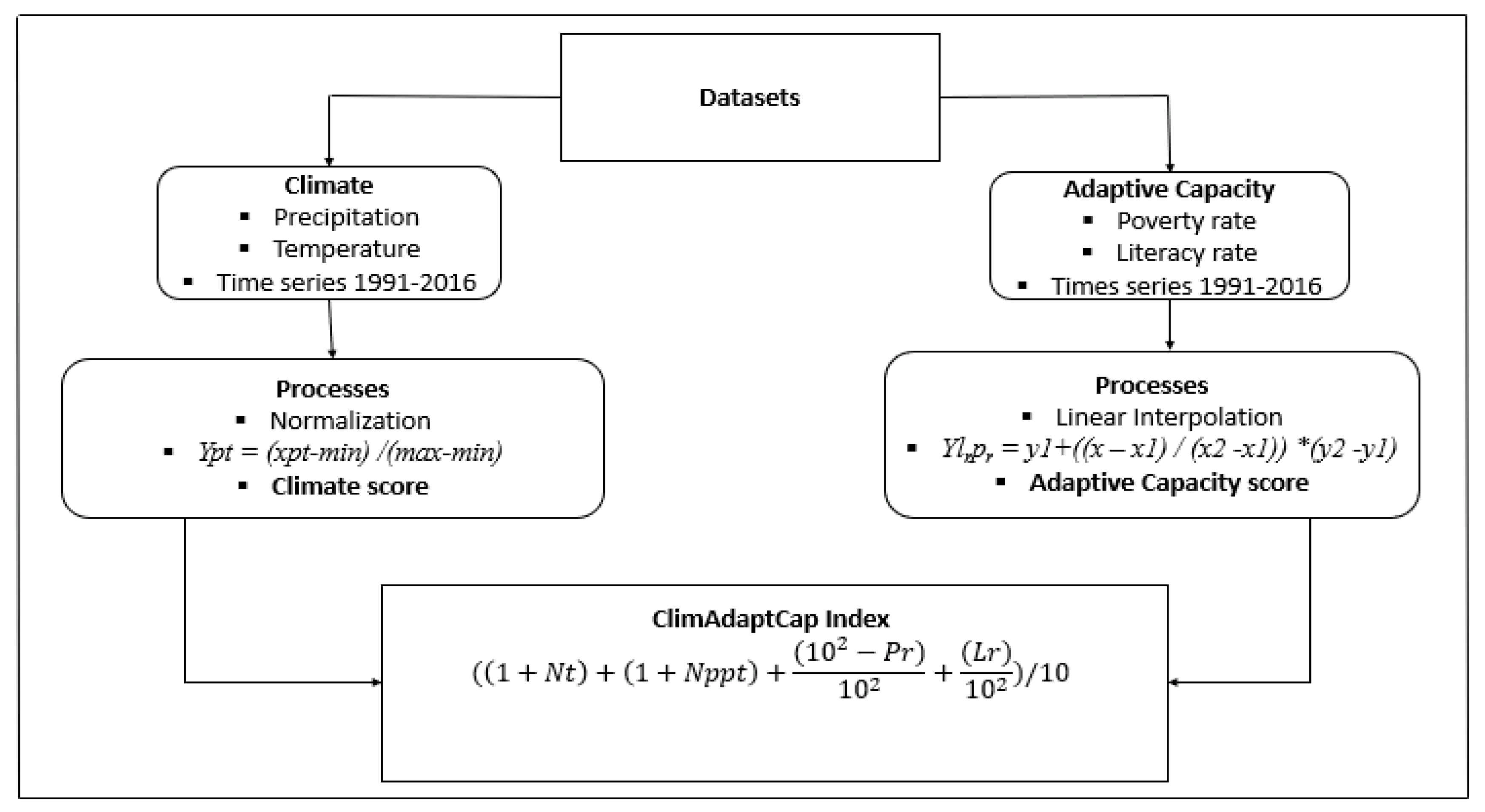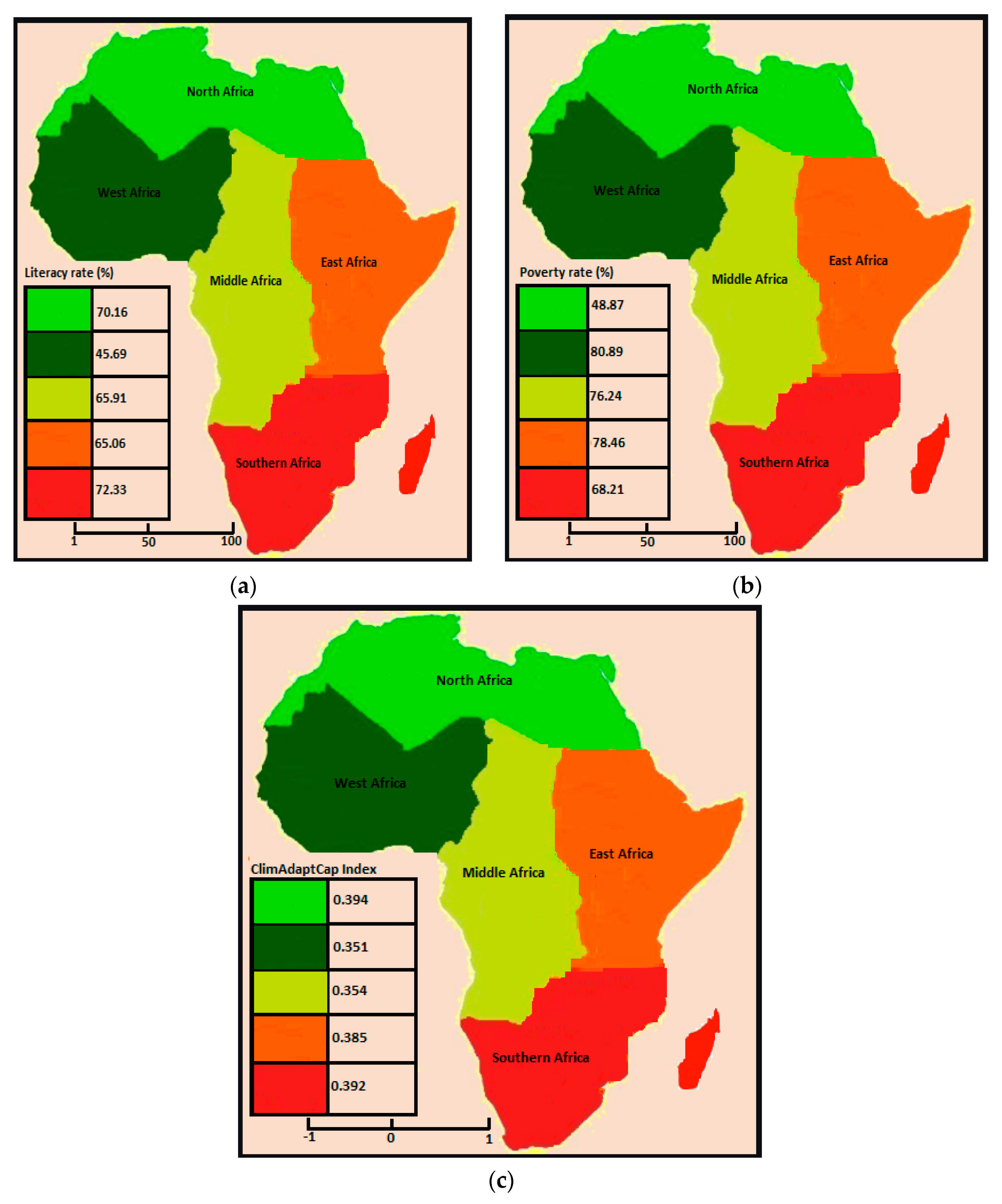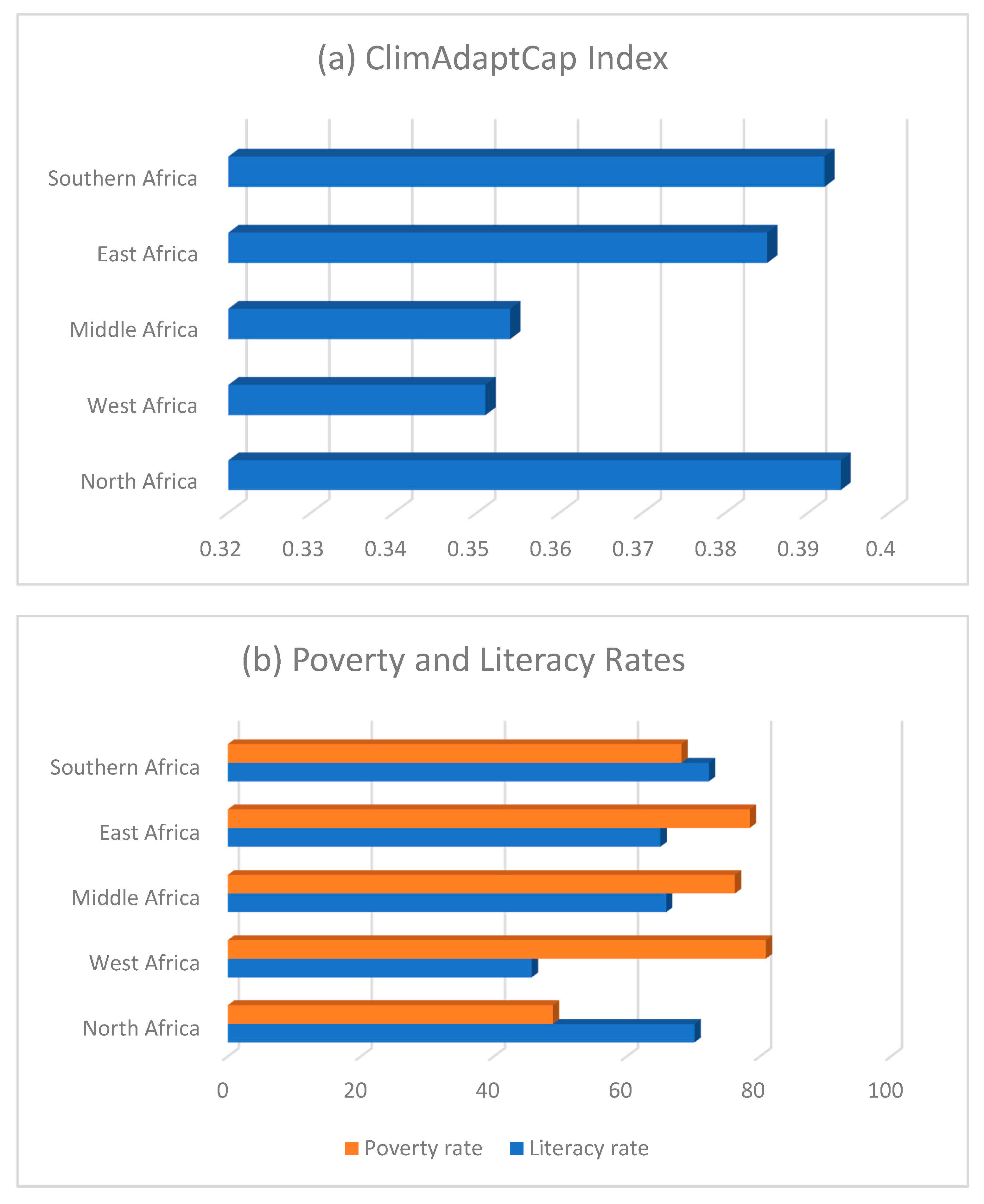The Readiness Index for Climate Change Adaptation in Africa: The Role of Climate and Adaptive Capacity Proxies
Abstract
:1. Introduction
2. Materials and Methods
2.1. Data Collection
2.2. Data Analysis
2.2.1. Linear Interpolation
2.2.2. Normalization of Data
2.2.3. Calibration of Readiness Index/ClimAdaptCap Index
3. Results
3.1. Recent Climate Trends across Africa
3.2. Recent Literacy and Poverty Rates across Africa
3.3. Readiness for Climate Change Adaptation across Africa
4. Discussion
5. Conclusions
Supplementary Materials
Author Contributions
Funding
Institutional Review Board Statement
Informed Consent Statement
Data Availability Statement
Acknowledgments
Conflicts of Interest
References
- New, G.M.; Hewitson, B.; Stephenson, D.B.; Tsiga, A.; Kruger, A.; Manhique, A.; Gomez, B.; Coelho, C.A.S.; Masisi, N.D.; Kululanga, E.; et al. Evidence of trends in daily climate extremes over southern and west Africa. J. Geophys. Res. D Atmos. 2016, 111, D14102. [Google Scholar] [CrossRef]
- Niang, I.; Ruppel, O.C.; Abdrabo, M.A.; Essel, A.; Lennard, C.; Padgham, J.; Urquhart, P. Africa. Climate Change 2014: Impacts, Adaptation, and Vulnerability. Part B: Regional Aspects. In Contribution of Working Group II to the Fifth Assessment Report of the Intergovernmental Panel on Climate Change; Barros, V.R., Field, C.B., Dokken, D.J., Mastrandrea, M.D., Mach, K.J., Bilir, T.E., Chatterjee, M., Ebi, K.L., Estrada, Y.O., Genova, R.C., et al., Eds.; Cambridge University Press: Cambridge, UK; New York, NY, USA, 2014; pp. 1199–1265. Available online: https://www.ipcc.ch/site/assets/uploads/2018/02/WGIIAR5-Chap22_FINAL.pdf (accessed on 12 August 2021).
- IPCC. Climate Change 2007: The Physical Science Basis. In Contribution of Working Group I to the Fourth Assessment Report of the Intergovernmental Panel on Climate Change; Solomon, S., Qin, D., Manning, M., Marquis, M., Averyt, K.B., Tignor, M., Miller, H., Chen, Z., Eds.; IPCC: Geneva, Switzerland; Cape Town, South Africa, 2007. [Google Scholar]
- James, R.; Washington, R. Changes in African temperature and precipitation associated with degrees of global warming. Clim. Chang. 2013, 117, 859–872. [Google Scholar] [CrossRef]
- Mora, C.F.; Frazier, A.G.; Longman, R.J.; Dacks, R.S.; Walton, M.M.; Tong, E.J.; Sanchez, J.J.; Kaiser, L.R.; Stender, Y.O.; Anderson, J.M.; et al. The projected timing of climate departure from recent variability. Nature 2013, 502, 183–187. [Google Scholar] [CrossRef]
- Benkenstein, A. Climate Change Adaptation Readiness: Lessons from the 2015/2016 El Niño for Climate Readiness in Southern Africa; JSTOR: New York, NY, USA, 2017. [Google Scholar]
- Biasutti, M.; Giannini, A. Robust Sahel drying in response to late 20th century forcings. Geophys. Res. Lett. 2006, 33, L11706. [Google Scholar] [CrossRef] [Green Version]
- Greene, A.M.; Giannini, A.; Zebiak, S.E. Drought return times in the Sahel: A question of attribution. Geophys. Res. Lett. 2009, 36, L12701. [Google Scholar] [CrossRef] [Green Version]
- IPCC. Climate Change 2014: Synthesis Report. In Contribution of Working Groups I, II and III to the Fifth Assessment Report of the Intergovernmental Panel on Climate Change; Pachauri, R.K., Meyer, L.A., Eds.; IPCC: Geneva, Switzerland, 2014; pp. 1–151. [Google Scholar]
- Collier, P.; Conway, G.; Venables, T. Climate change and Africa. Oxf. Rev. Econ. Policy 2008, 24, 337–353. [Google Scholar] [CrossRef]
- Toulmin, C. Climate Change in Africa; Zed Books Ltd.: London, UK, 2009. [Google Scholar]
- Khan, A.; Amelie, V. Assessing climate change readiness in Seychelles: Implications for ecosystem-based adaptation mainstreaming and marine spatial planning. Reg. Environ. Chang. 2015, 15, 721–733. [Google Scholar] [CrossRef]
- Simelton, E.; Fraser, E.D.G.; Termansen, M.; Foster, P.M.; Dougill, A.J. Typologies of crop-drought vulnerability: An empirical analysis of the socioeconomic factors that influence the sensitivity and resilience to drought of three major food crops in China (1961–2001). Environ. Sci. Policy 2009, 12, 438–452. [Google Scholar] [CrossRef]
- Epule, T.E.; Ford, J.D.; Lwasa, S.; Lepage, L. Vulnerability of maize yields to droughts in Uganda. Water 2017, 9, 181. [Google Scholar] [CrossRef] [Green Version]
- Department of Disaster Management, Office of the Prime Minister. The 2010–2011 Integrated Rainfall Variability Impacts, Needs Assessment and Drought Risk Management Strategy; Office of Prime Minster of Uganda: Kampala, Uganda, 2012.
- Herrmann, S.M.; Tappan, G.G. Vegetation impoverishment despite greening: A case study from central Senegal. J. Arid Environ. 2013, 90, 55–66. [Google Scholar] [CrossRef]
- Nhamo, G. Green economy readiness in South Africa: A focus on the national sphere of government. Int. J. Afr. Renaiss. Stud. Multi Inter. Transdiscipl. 2013, 8, 115–142. [Google Scholar] [CrossRef]
- World Bank Group. Indicators. 2021. Available online: https://data.worldbank.org/indicator/SE.ADT.LITR.ZS?locations=DZ (accessed on 11 March 2021).
- Nicholson, S.E. Rainfall and atmospheric circulation during drought periods and wetter years in West Africa. Mon. Weather Rev. 1981, 109, 2191–2208. [Google Scholar] [CrossRef] [Green Version]
- Tilleard, S.; Ford, J. Adaptation readiness and adaptive capacity of transboundary river basins. Clim. Chang. 2016, 137, 575–591. [Google Scholar] [CrossRef]
- Lwasa, S. Adapting urban areas in Africa to climate change: The case of Kampala. Curr. Opin. Environ. Sustain. 2010, 2, 166–171. [Google Scholar] [CrossRef]
- World Bank Group. Download Historical Data. 2021. Available online: https://climateknowledgeportal.worldbank.org (accessed on 12 March 2021).
- Epule, T.E.; New, M.G. Vulnerability of crop yields to variations in growing season precipitation in Uganda. SN Appl. Sci. 2019, 1, 1–13. [Google Scholar] [CrossRef] [Green Version]
- Antwi-Agyei, P.; Fraser, E.D.G.; Dougill, A.; Stringer, A.J.; Simelton, E. Mapping the vulnerability of crop production to drought in Ghana using rainfall, yield, and socioeconomic data. Appl. Geogr. 2012, 32, 324–334. [Google Scholar] [CrossRef]
- Sherman, M.; Ford, J.D. Market engagement and food insecurity after a climatic hazard. Glob. Food Sec. 2013, 2, 144–155. [Google Scholar] [CrossRef]
- Macro Trends. 2021. Available online: https://www.macrotrends.net/ (accessed on 11 March 2021).
- Epule, T.E. Readiness Index_Dataset.xlsx. Figshare. Dataset. 2021. Available online: https://figshare.com/articles/dataset/Readiness_Index_Dataset_xlsx/16550109 (accessed on 31 August 2021).
- Ford, J.D.; King, D. A framework for examining adaptation readiness. Mitig. Adapt. Strateg. Glob. Chang. 2015, 20, 505–526. [Google Scholar] [CrossRef]
- Nicholson, S.E. A multi-century history of drought and wetter conditions in Africa. Palgrave Handb. Clim. Hist. 2018, 225–236. [Google Scholar]
- Bichet, A.; Diedhiou, A. West African Sahel has become wetter during the last 30 years, but dry spells are shorter and more frequent. Clim. Res. 2018, 75, 155–162. [Google Scholar] [CrossRef] [Green Version]
- Herrmann, S.M.; Anyamba, A.; Tucker, C.J. Recent trends in vegetation dynamics in the African Sahel and their relationship to climate. Glob. Environ. Chang. 2005, 15, 394–404. [Google Scholar] [CrossRef]
- Ibrahim, Y.Z.; Balzter, H.; Kaduk, J.; Tucker, C.J. Land degradation assessment using residual trend analysis of GIMMS NDVI3g, soil moisture and rainfall in Sub-Saharan West Africa from 1982 to 2012. Remote Sens. 2015, 7, 5471–5494. [Google Scholar] [CrossRef] [Green Version]
- Juo, A.S.R. New farming systems development in the wetter tropics. Exp. Agric. 1989, 25, 145–163. [Google Scholar] [CrossRef]
- Vizy, E.K.; Cook, K.H.; Crétat, J.; Neupane, N. Projections of a wetter Sahel in the twenty-first century from global and regional models. J. Clim. 2013, 26, 4664–4687. [Google Scholar] [CrossRef]
- Olsson, L.; Eklundh, L.; Ardö, J. A recent greening of the Sahel—trends, patterns, and potential causes. J. Arid Environ. 2005, 63, 556–566. [Google Scholar] [CrossRef]
- Johnson, T.C.; Werne, J.P.; Brown, E.T.; Abbott, A.; Berke, M.; Steinman, B.A.; Halbur, J.; Contreras, S.; Grosshuesch, S.; Deino, A.; et al. A progressively wetter climate in southern East Africa over the past 1.3 million years. Nature 2016, 537, 220–224. [Google Scholar] [CrossRef] [PubMed]
- Hazell, P.B.; Oram, P.A.; Chaherli, N.M. Managing Droughts in the Low-Rainfall Areas of the Middle East and North Africa (No. 581-2016-39495); International Food Policy Research Institute: Washington, DC, USA, 2001. [Google Scholar]
- Rowell, D.P.; Folland, C.K.; Maskell, K.; Ward, M.N. Variability of summer rainfall over tropical North Africa (1906–92): Observations and modelling. Q. J. R. Meteorol. Soc. 1995, 121, 669–704. [Google Scholar]
- Zittis, G. Observed rainfall trends and precipitation uncertainty in the vicinity of the Mediterranean, Middle East, and North Africa. Theor. Appl. Climatol. 2018, 134, 1207–1230. [Google Scholar] [CrossRef]
- Schilling, J.; Freier, K.P.; Hertig, E.; Scheffran, J. Climate change, vulnerability, and adaptation in North Africa with focus on Morocco. Agric. Ecosyst. Environ. 2012, 156, 12–26. [Google Scholar] [CrossRef]
- Lelieveld, J.; Proestos, Y.; Hadjinicolaou, P.; Tanarhte, M.; Tyrlis, E.; Zittis, G. Strongly increasing heat extremes in the Middle East and North Africa (MENA) in the 21st century. Clim. Chang. 2016, 137, 245–260. [Google Scholar] [CrossRef] [Green Version]
- Oomes, N.; Heyma, A.; Belt, T.; Berthiaume, N.; Bisschop, P.; Jongerius, D.; Spanikova, V.; Kaag, M.M.A. Dutch labour market shortages and potential labour supply from Africa and the Middle East: Is there a match? Exec. Summ. Main Rep. 2019. [Google Scholar]
- Posel, D. Adult literacy rates in South Africa: A comparison of different measures. Lang. Matters 2011, 42, 39–49. [Google Scholar] [CrossRef]
- UNESCO Institute for Statistics. Adult and Youth Literacy: National, Regional, and Global Trends, 1985–2015; UNESCO Institute for Statistics: Montreal, QC, Canada, 2013. [Google Scholar]
- Akkari, A. Education in the Middle East and North Africa: The current situation and future challenges. Int. Educ. J. 2004, 5, 144–153. [Google Scholar]
- Obikili, N. The impact of the slave trade on literacy in West Africa: Evidence from the colonial era. J. Afr. Econ. 2016, 25, 1–27. [Google Scholar] [CrossRef] [Green Version]
- World Bank Group. Reversal of Fortunes: Poverty and Shared Prosperity. 2020. Available online: https://openknowledge.worldbank.org/bitstream/handle/10986/34496/9781464816024.pdf (accessed on 21 May 2021).
- Brooks, N.; Adger, W.N.; Kelly, P.M. The determinants of vulnerability and adaptive capacity at the national level and the implications for adaptation. Glob. Environ. Chang. 2005, 15, 151–163. [Google Scholar] [CrossRef]






| North Africa | West Africa | Middle Africa | East Africa | Southern Africa |
|---|---|---|---|---|
| Morocco | Mauritania | Cameroon | Sudan | Namibia |
| Algeria | Senegal | Central African Republic | Eritrea | Zambia |
| Tunisia | Gambia | Congo | Ethiopia | Malawi |
| Libya | Guinea Bissau | Democratic Republic of Congo | Somalia | Zimbabwe |
| Egypt | Guinea | Angola | Uganda | Botswana |
| Sierra Leone | Gabon | Kenya | Mozambique | |
| Liberia | Sao Tome and Principe | Tanzania | Lesotho | |
| Cote D’Ivoire | Rwanda | Swaziland | ||
| Ghana | Burundi | South Africa | ||
| Togo | Djibouti | Madagascar | ||
| Benin | Seychelles | Mauritius | ||
| Nigeria | ||||
| Niger | ||||
| Mali | ||||
| Burkina Faso Chad Cape Verde |
Publisher’s Note: MDPI stays neutral with regard to jurisdictional claims in published maps and institutional affiliations. |
© 2021 by the authors. Licensee MDPI, Basel, Switzerland. This article is an open access article distributed under the terms and conditions of the Creative Commons Attribution (CC BY) license (https://creativecommons.org/licenses/by/4.0/).
Share and Cite
Epule, T.E.; Chehbouni, A.; Dhiba, D.; Moto, M.W. The Readiness Index for Climate Change Adaptation in Africa: The Role of Climate and Adaptive Capacity Proxies. Appl. Sci. 2021, 11, 9413. https://doi.org/10.3390/app11209413
Epule TE, Chehbouni A, Dhiba D, Moto MW. The Readiness Index for Climate Change Adaptation in Africa: The Role of Climate and Adaptive Capacity Proxies. Applied Sciences. 2021; 11(20):9413. https://doi.org/10.3390/app11209413
Chicago/Turabian StyleEpule, Terence Epule, Abdelghani Chehbouni, Driss Dhiba, and Mirielle Wase Moto. 2021. "The Readiness Index for Climate Change Adaptation in Africa: The Role of Climate and Adaptive Capacity Proxies" Applied Sciences 11, no. 20: 9413. https://doi.org/10.3390/app11209413
APA StyleEpule, T. E., Chehbouni, A., Dhiba, D., & Moto, M. W. (2021). The Readiness Index for Climate Change Adaptation in Africa: The Role of Climate and Adaptive Capacity Proxies. Applied Sciences, 11(20), 9413. https://doi.org/10.3390/app11209413






